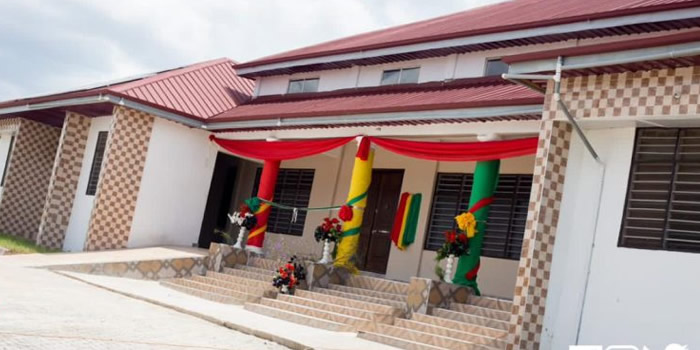

Health Care Provision in the District
Under health care in the district, issues discussed include health infrastructure and professionals, access to health facility in the district, the status of the District Health Insurance Scheme and HIV/AIDS prevalence in the district.
District Health Facilities and Management in the District
Health delivery in the Atwima Mponua District is through eleven (11) Government and five (5) Non-government facilities: one (1) hospital, eight (8) health centers, seven (7) clinics/ maternity/child health facilities. In addition, outreach clinical activities are organised in all communities by the staff of the Sub-district facilities.
With respect to health personnel, the District has one (1) medical officer, four (4) medical assistants, 28 mid-wives, 128 enrolled nurses and 54 community health nurses and 49 Traditional Birth Attendants providing health services in both the public and private health institutions in the district. The location, management and facilities available in the District are presented in Table 1.30.
Table 1.29 shows that health personnel in the District are highly overstretched; with the current projected population of 126,894; the implication is that only one medical officer serves 126,894 people. The nurse/population ratio is about 1:697. There is therefore the need to bridge the equity gap in both financial, geographical and personnel access to quality health care in the District.
Proposed Site for Location of New Health Care Facilities
The bar graph above shows that, the average distance to the nearest health facilities by the communities without access to health care is 11.45km with a standard deviation of 3.09km.
From the study, in order to improve the health status of the people in the district by ensuring access between settlements and the health care facilities, the study identified fourteen locations (14) for siting new health facilities (Debra camp, Wansamire, Desreagya, Kyekyewere, Abasua, Bedabour, Asaman, Anwiafutu, Achiase, Kramokrom, Kufour Camp, Anansu, Manukrom and Okyerekrom that could potentially deliver healthcare services to a greater number of people in the district (See Figure 3). The proposed sites have a total of 61 communities with a population of 39,626 (that is 26.39% of district population and 33.8% of the total communities in the district) in their catchments or service area. Currently, populations in these communities indirectly have no access to health care facility. On the average, people in these areas cover not less than 11.45km to access health care services.
The 10 top diseases in the District as obtained from the District Health Directorate are shown in Table 1.30. Among the top 10 diseases, Malaria (32.9 %) recorded the highest followed by Upper Respiratory Tract Infections (14.9%), Diarrhoea Diseases (5.3%) and Occupational Injuries (0.5%) recorded the least. Most of the diseases are due to poor environmental sanitation and Malaria continues to be on top of the list of all diseases in the District since 2014. In addition to the “common” diseases tabulated, other diseases such as Buruli Ulcer, Guinea worm, Yaws and Yellow fever are of great concern in the District.
Major Diseases Prone Areas in the District Map
The major diseases considered included HIV/AIDS, Malaria and Buruli Ulcer. These diseases were considered based on their negative effects on the human resource base of the district. In addition, the financial implication of these diseases to the affected family was also relevant indicator.
Based on the map, buruli ulcer is a widespread disease in the district. The disease is more prevalent in communities located in the Northern and the South-Western parts of the district such as Abompe, Beposo, Bedabour, Kotokuom, Tanodumase, K.D Sreso, Gyereso and Anansu.
Ntobroso, Adobewora, Achiase and all the surrounding communities are also associated with all the major diseases identified in the district. HIV/AIDS, malaria and buruli ulcer are all common in these communities. The cause of this phenomenon in the area is associated with the intense mining and poor sanitation conditions in these communities.
Status of District Health Insurance Scheme
The national health insurance scheme (NHIS) was established as part of a poverty reduction strategy to make health care affordable to all Ghanaians.
The Atwima Mponua Mutual Health Insurance Scheme was carved out from the Atwima Nwabiagya Mutual Health Insurance Scheme in 2006. In its first year of operation, the scheme registered 12.6 percent of the district population representing 16, 170 persons. With regards the period under review (2014-2017), the scheme has a witnessed a sharp increment in registration from 2014 to 2015 and a marginal declined from 2015 to 2016 in relation to total population of the district. The scheme was the best performing district in 2014 and 2015 nationwide in terms of registration.
In 2014, the scheme registered 63,683 persons representing 51.4 percent of the total population of 123, 862. This had increased to 89,606 representing 71.89 percent of the total population of 124,640. This increment dropped to 78,274 representing 62.24 percent of the total population of 125,762 in 2016. As at April, 2017, the scheme registered 9,717 representing 7.65 percent of the total population of 126,894. The details are presented in Figure 1.21.
The above figures present a declining registration of clients from 2016. This trend can attributed to the continuous shortage of ID cards and consumables with the period, inadequate office space, and frequent breakdown of office equipment among other challenges.
Development Implications
The increased in the registration levels recorded in 2014 and 2015 means that, all things been equal, people will have access to basic health care in the district. However, with the recent decline in the registration of clients in the district due to challenges stated above, it will affect health access in district. People are likely to resort to traditional medicines which are currently not regulated in the country. Measures to tackle the challenges facing the scheme from both internal and external sources should be proactive.
Access to Health Facilities
Descriptive Statistics of Population Variables from the Spatial Analysis
The computed average distance a patient travels to seek for healthcare (average travel impedance to provider) for the entire district. The results indicate that, averagely, a person has to cover 6.63km to access the nearest health facility in the district. The network analysis performed gave the following results; 73.6 percent of the total population in the district comprising 66.1 percent of the total communities has access to health care facility using accessibility standards. This implies that from the results of network analysis, 33.8 percent of the entire district population.
The results of network analysis was preferable to that of the proximity analysis since it take all road networks into consideration, without considering only a straight distance from health facility. The result of network analysis makes it possible to identify new site where additional health facility can be put up to improve accessibility of primary health care services in the district. In addition to the general average accessibility, the analysis was also narrowed to the individual sub-districts where facilities exist. The bar graphshows average distances to the nearest health facilities by the individual sub-districts in the study area measured in kilometers. Sreso sub-district recorded the highest average distance (8.41km) to the nearest health facility, followed by Gyereso Sub-district (8.39km) and the least was Saakrom Sub-district (5.12km).
Maternal and Infant Mortality Rate
The age-specific death rates for males (0.005) and females (0.005) are the same despite the fact that in absolute terms the deaths among males (326) are more than females (313). The proportion of 70 years and older (0.024) records the highest age-specific death rate followed by 65-69 years (0.016) and 60-64 years (0.010). In terms of absolute figures, death among under-five years is the highest among all the age cohorts.
The results indicate that death rates among females were higher than those of males among the age groups 15-49 years, a possible indication of relatively high maternal mortality in the District. This means that the patterns are slightly higher for female in the childbearing age range (15-49 years).
Thus, the age-specific death rates are higher for females at aged 15-19, 25-29, 30-34, 35-39, 40-44 and 65-69 than males. However, the age-specific death rates for females are slightly lower than males at aged under-five, 10-14, 45-49, 50-54, 55-59, and 70 years and older.
The under-five mortality is defined as the combination of infant and child mortality and is defined as the probability of dying between birth and exact age five according to the 2010 PHC. The under-five mortality rate was 0.47 (4) in 2014. In comparison, the under-five mortality rate for the District that is eight per 1,000 live births is lower than the regional average of 12 per 1,000 live births and national average of 13 per 1,000 live births. This indicates that for every 1,000 live births in the District, eight may possibly not survive. In regards to sex, the under-five mortality for males (0.009) is slightly higher than females (0.008) indicating that for every 1,000 live births females survive more than males.
HIV/AIDS Gender Analysis
HIV/AIDS continue to be a major disease in the country. The Atwima Mponua District HIV/AIDS situation has been compounded by the mining activities in the area. The results of people living with HIV/AIDS in the district presented in Table represents the result of walk-in testing at the various PMTCT centres in the district and few mass testing conducted within the period under review.
On the yearly basis, the district falls within the forty (40) margin for four years (2014, 2016, and 2017) and doubled the forty (40) margins in 2015. The high number recorded in 2015 as presented in the Table is attributed the massive testing done by the PMTCT centres with support from Rural Relief Services (NGOs) and the Ghana Aids Commission. This means that, the numbers will even go up if more testing is conducted.
On sex basis, the females have the majority of people living with HIV/AIDS in the district. The female gender continues to record high numbers in all the years under review as show in Table 1.32. This is a result of the high number of females with multiple sex partners in district who lack knowledge in HIV/AIDS prevention measures highly attributed to ignorance.
With regards to the age cohorts, those ranging from 20-50+ years are the most affected. However, there was an uncommon case recorded in the 0-9 age cohorts in 2015 and 2014. This according to the district health directorate is person born with the disease. That is mother-to-child transmission.
Cumulatively, a total of 221 people have contracted and are living with HIV/AIDS in the district for the past four years. This represented 0.17 percent of the total projected population of 126,984 in 2017. This is a worrying trend in the combat against HIV/AIDS in the district.
Development Implication
The number of people living with virus is worrying due to its effects on human resource base of the district. It effects on their respective families and the local economy cannot be over-emphasized. Effective education that can break the religious and cultural perceptions about HIV/AIDS prevention methods must be proactively implemented by the Assembly, the Ghana Aids Commission as well as local and international NGOs.
PMTCT of Health Facilities in the District
The District Assembly through the district health directorate in its quest to make HIV/AIDS services are available to the citizenry has established some PMTCT centres in some selected health facilities within the district. Table presents the various PMTCT centres in the district and the services they provide.
Date Created : 11/24/2017 2:50:57 AM













 facebook
facebook
 twitter
twitter
 Youtube
Youtube
 +233 593 831 280
+233 593 831 280 0800 430 430
0800 430 430 GPS: GE-231-4383
GPS: GE-231-4383 info@ghanadistricts.com
info@ghanadistricts.com Box GP1044, Accra, Ghana
Box GP1044, Accra, Ghana